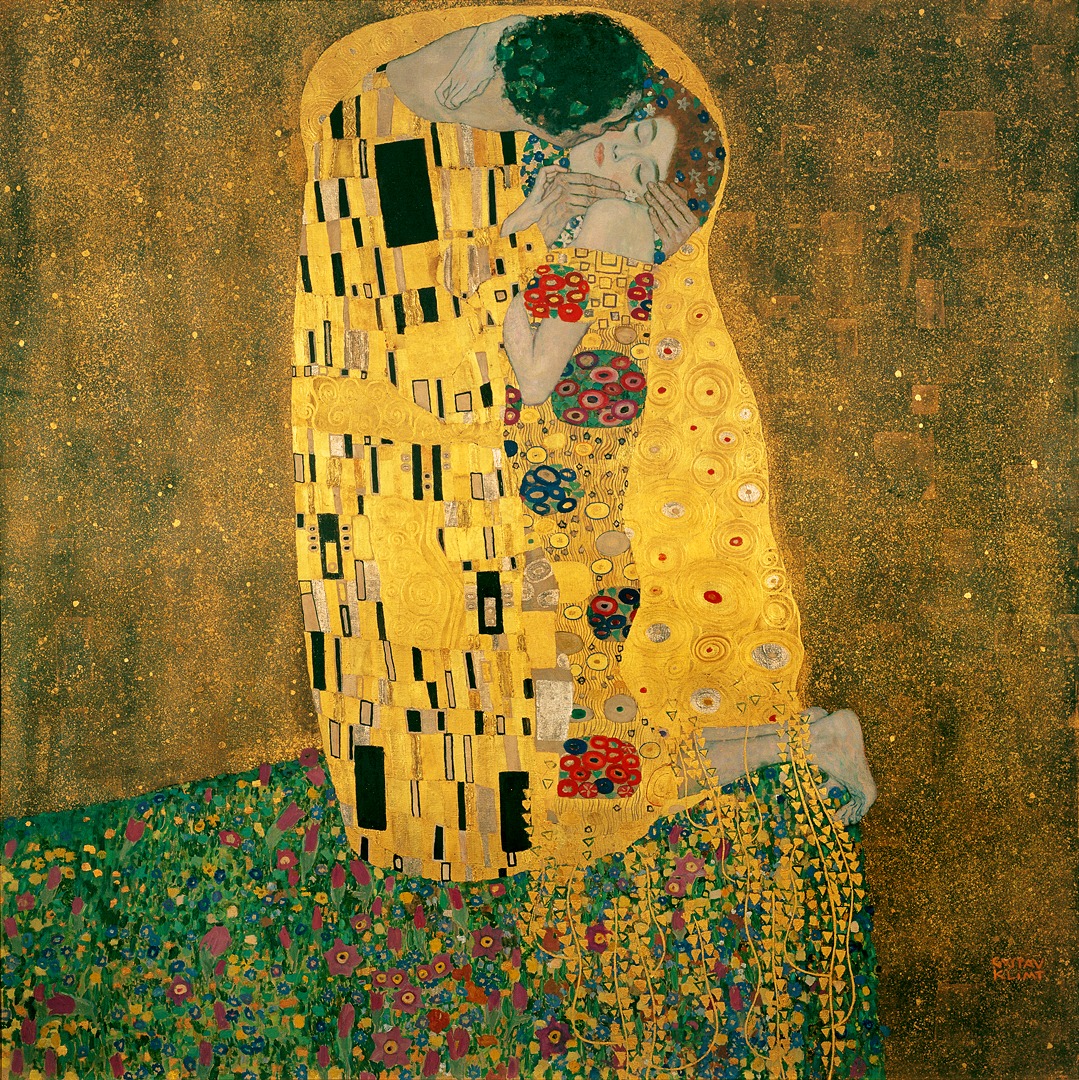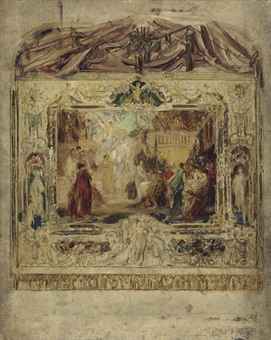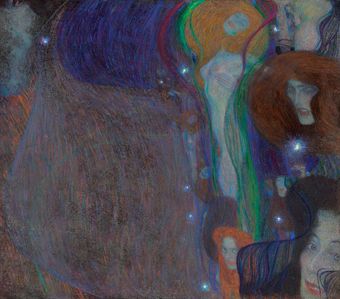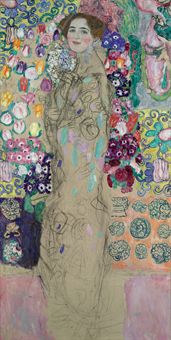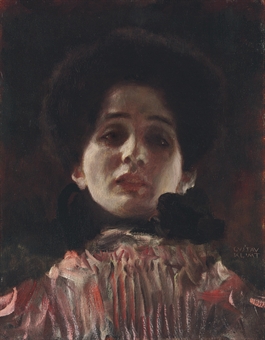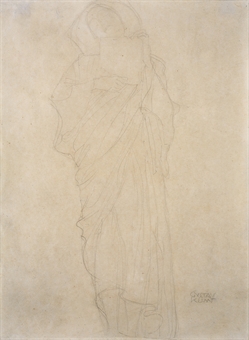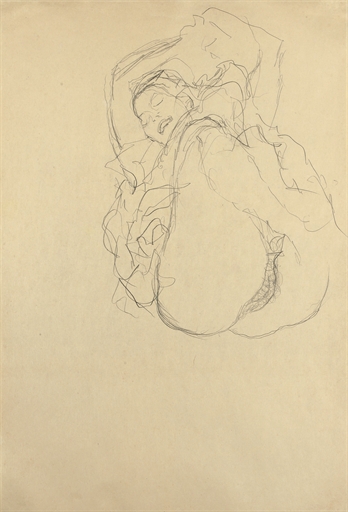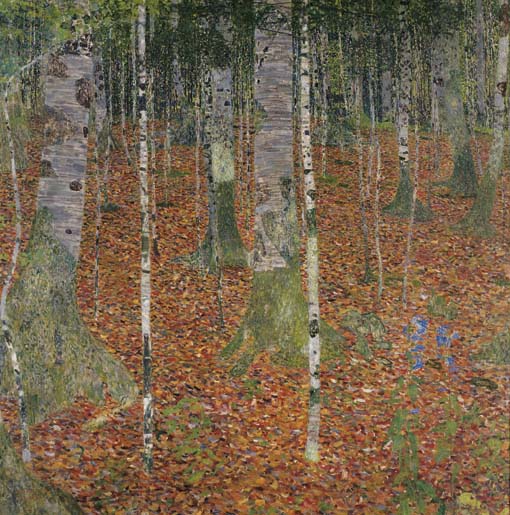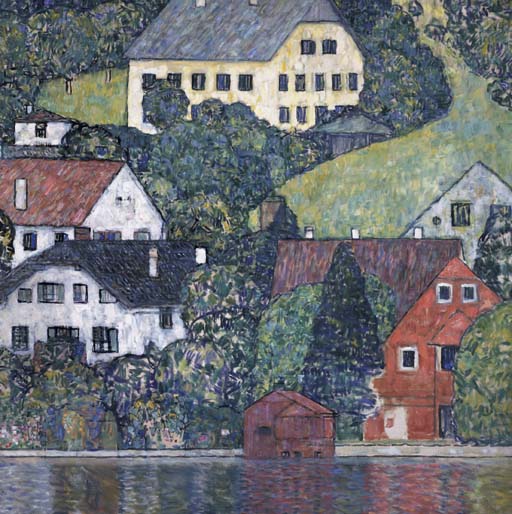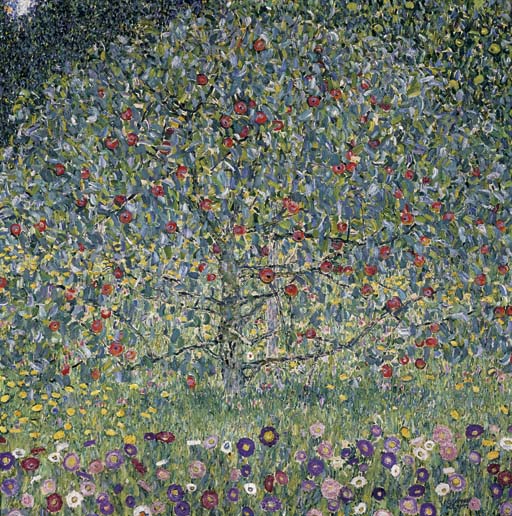Impressionist & Modern Art Evening Sale Sotheby’s 1 March 2017
D
Gustav Klimt, Bauerngarten (Blumengarten), oil on canvas, painted in 1907 (Estimate upon request)
Among the finest works by Gustav Klimt ever to come to auction, Bauerngarten was painted during the golden years of Klimt’s career and was a highlight of the critically acclaimed Painting the Modern Garden exhibition at the Royal Academy of Arts in London last year. This profoundly beautiful work is to be offered at auction for the first time in over two decades, set to lead Sotheby’s Impressionist & Modern Art Evening Sale in London on 1 March 2017.
KLIMT’S GOLDEN YEARS
While Klimt is largely revered for his opulent, symbol-laden portraits of the Viennese bourgeoisie, these works were just one aspect of his artistic expression. It is, arguably, in his landscapes, that he found the freedom to express himself, and to experiment, more freely. His landscapes, therefore, not only represent an important and highly personal facet of his career, but are also critical to our appreciation of the artist.
One of Gustav Klimt’s finest landscapes, Bauerngarten was first exhibited in the landmark 1908 Kunstschau in Vienna; a pivotal moment for Klimt – who had not had a public showing of his work for three years – the exhibition caused a sensation and confirmed the status of Klimt as the leading modern artist of his time. Even then the luminous painting was considered important, acquired just two years after by the National Gallery in Prague.
Landscapes are integral to Klimt’s oeuvre, revealing a more personal and experimental side to his painting that differs from his portraits, which were, for the most part, commissions. At the same time, even in his landscapes, there is often an echo of a figure – here, the shape of a woman is almost tangible under the triangular composition of blazing colours of the flowers. Indeed, Bauerngarten was painted at the same moment as some of Klimt’s most celebrated and innovative figurative works, including his golden portrait of Adele Bloch-Bauer and
the gilded Der Küss.
Gustav Klimt, Adele Bloch-Bauer I, 1907, oil and gold on canvas, Neue Galerie, New York
The joyous mood of the painting tells a story too. Each summer, Klimt would retreat to the shore of Attersee for three months to relax and paint, accompanied by family and friends including his lifelong companion, the celebrated designer Emilie Flöge. It was a happy time, and the inspiration for Bauerngarten was found in the rustic garden of a local farmer, with its informal profusion of poppies, daisies and roses transformed into a shimmering array of colour.
KLIMT & HIS CONTEMPORARIES
The influence of Impressionist and Post-Impressionist artists on Klimt’s landscapes is evident, from Claude Monet’s treatment of his famous waterlily pond to Vincent van Gogh’s ability to make canvases pulsate with energy.
The square canvas chosen by Kilmt for this work heightens its visual impact, and it was in the same decade that Monet started to use this format to depict his waterlily ponds at Giverny. Both Klimt and Monet used this technical innovation to break away from the accepted form of traditional landscape art. Stripping away the sky, both artists created increasingly abstract ideas of the landscapes they were creating, focusing less on faithful renderings but more on the fleeting yet joyous patterns and colours.
In 1906, Klimt attended an exhibition of works by van Gogh in Vienna, and his subsequent appreciation of van Gogh sparked a significant shift in his appreciation of paint. Drawing on this, the dynamic brushwork and vibrancy of Bauerngarten reflect this turning point in Klimt’s style.
GUSTAV KLIMT (1862 – 1918)
A market sensation (ranking among the few artists whose work has achieved over $100 million); Gustav Klimt is widely acknowledged as one of the founding fathers of Modern Art. Celebrated for his highly decorative style – a style that draws on his contemporaries Monet and Van Gogh but is at the same time unique – his unfading popularity is down not only to the universal themes with which he worked (love, beauty and death), but also to the ornate and jewel-like surfaces he created, thanks in no small part to the influence of Japanese art.
Sotheby's 2015
Gustav
Klimt’s extraordinarily beautiful and captivating portrait Bildnis Gertrud Loew
of 1902 will be offered for sale in the 24th June Impressionist
& Modern Art Evening Sale following a settlement between the Felsöványi family
and The Gustav Klimt | Wien 1900-Privatstiftung (Klimt Foundation).
The
painting (est. £12-18 million / $18.5-27.7 million / €16.8-25.3 million)
depicts the ethereal figure of Gertrud Loew, later known by her married name
Gertha Felsöványi, a member of fin-de-siècle Viennese society, wreathed in
diaphanous folds of gossamer fabric.
Helena
Newman, Sotheby’s Co-Head of Impressionist & Modern Art Worldwide said:
“Gustav Klimt’s exquisite and ingenious representations of women have led him
tobecome the most celebrated painter of the female portrait of the early 20th
Century. Bildnis Gertrud Loew, froma crucial period in the artist’s career,
isone of his finest portraits to appear at auctionin over twenty years.”
Gertrud Felsöványi’s granddaughter, commenting on behalf of the family heirs, said:
“This portrait portrays the brave and determined nature of my grandmother. Her strength of character and beauty lives on in this visual embodiment. My father, Anthony Felsöványi, last saw this painting in June 1938 when he left the family home for the last time to depart for America. At that time my grandmother had been advised to leave her family home to live in a less grand home to try to avoid the attention of the Nazis, given her Jewish ancestry. Eventually, under duress, in 1939 she left Vienna altogether to join my father in America, having left all of her belongings behind -including this painting. Her home had been taken over as a Nazi headquarters and she had left her valuable belongings with friends and acquaintances. After the war, she never returned to Vienna. Only my father’s sister did, with the hope of retrieving some of their belongings, but to no avail. My father said that my grandmother never again mentioned the painting or the valuable belongings she had left behind.“My father recalled that throughout his childhood the painting was displayed in the entrance hall of their family home. It was displayed prominently on a stand rather than hung on the wall, and faced out to the gardens. After he had left Vienna, my father hung a reproduction of the Klimt portrait of his mother in his home in America. While sadly my father is no longer alive, having died two years ago aged ninety-eight, this settlement would have meant a great deal to him, as it does to me and the other family heirs with whom this settlement has been agreed. Before his death my father had wanted to thank Mrs Ucicky for her longstanding desire to work towards this settlement, and our family wishes to thank her as well as the researchers and others involved in bringing about this resolution.”
Bildnis
Gertrud Loew was commissioned by Gertrud’s father Dr Anton Loew, at the time
one of the most celebrated physicians in Vienna. The Loew family lived in a
palatial residence adjoining the Sanitorium Loew –the largest and grandest
private sanatorium in Vienna where a number of important fin-de-siècle figures
were treated, including Gustav Mahler and Gustav Klimt, as well as Ludwig
Wittgenstein. The success of the Sanitorium enabled Anton Loew to acquire some
of the greatest masterpieces of the time, including
Ferdinand Hodler’s Der Auserwählte (now in the Kunstmuseum, Bern)
and a further important work by Gustav Klimt, Judith I (now housed in the Belvedere, Vienna).
He had also commissioned the artist Koloman Moser to design Gertrud and her first husband’s apartment in the Wiener Werkstätte style, but following Anton’s death Gertrud moved back to the family’s residence where she continued to run the Sanatorium. When the Nazis arrived in Vienna she came under increasing pressure due to her Jewish ancestry, and in early 1939 reluctantly agreed to leave Vienna for exile in the United States, leaving the entire Felsöványi art collection behind. When Gertrud’s daughter, Maria, returned to Vienna after the war to reclaim her family’s property she discovered that it had all been sold by her mother’s friend –herself under duress by persecution -and the Felsöványi family was not able to retrieve a single work of art. Untraceable by the Felsöványi family,by then Bildnis Gertrud Loew had been acquired by Gustav Ucicky, one of Gustav Klimt’s sons by Maria Ucicka who had modelled for the artist. Gustav Ucicky was a film director who rose to prominence during the Weimar Republic. He acquired a considerable number of works by his father, which he left to his wife Ursula after his death in 1961. In 2013 Ursula Ucicky established Gustav Klimt | Wien 1900-Privatstiftungwhich houses this collection of works and is also a non-profit cultural, art historical, scientific and educational centre. In addition to aiming to preserve and research the life and oeuvre of Gustav Klimt,Ursula Ucicky wished to research the history of the acquisition of the artworks in the collection, enlisting notable provenance experts to carry out the research. Following extensive research, a settlement between the Felsöványi family and the Klimt Foundation was reached under the Washington Conference Principles on Nazi-Confiscated Art and an agreement that Bildnis Gertrud Loew will be offered for sale.
Gertha Felsöványi
Gertrud Loew, known as Gertha, was nineteen years old when she was painted by Gustav Klimt in 1902. Dr Anton Loew had become one of the first benefactors of the Secession movement, co-sponsoring the building of the Secession, and in addition to works by Klimt, Hodler and Segantini, he collected antiques, baroque and renaissance art. In 1903 Gertha married Hans Eisler von Terramare in the Minoritenkirchein Vienna. After the early death of the couple’s only daughter Gertrude, the marriage fell apart. Gertha moved back into the family residence next to the Sanitorium and took over the running of the Sanatorium after Dr Anton Loew’s death in 1907. In 1912 she married the Hungarian industrialist Elemér Baruch von Felsöványi with whom she had three children. In November 1923 her husband caught pneumonia returning from a nightclub without an overcoat and died a few days later.
When the Nazis arrived in Vienna, Gertha was encouraged by her lawyer to leave her home and move into more modest accommodation, and then under increasing duress she reluctantly left in 1939, entrusting her artworks to a friend for safekeeping. Although her son Anthony was already living in America, Gertha was denied an entry visa and was not allowed to disembark when she docked in New York harbour; it was only through the intercession of Eleanor Roosevelt that she was allowed a day pass to spend Christmas 1939 with her son. She continued her journey to Colombia and spent time as a French teacher in Barranquilla while she waited for the grant of a US visa. In June 1940 she arrived in the USA where she started a new life, working nightshifts. When Gertha’s daughter Maria returned to Vienna after the war to reclaim her family’s property she discovered the fate of her family’s collection. Having learned about the losses of her father’s legacy, Gertha Felsöványi never returned to Austria. She died in Menlo Park, California in March 1964 at the age of 80.
A Portrait Painter of International Acclaim
Bildnis Gertrud Loew was exhibited on numerous occasions during the artist’s lifetime, both in Austria and Germany.The portrait was first exhibited in the Wiener Secession's Klimt exhibition in 1903 where it was reviewed by the great Viennese art critic,Ludwig von Hevesi, and describedas ‘. . .the most sweet-scented poetry the palette is able to create.’
Klimt’s foundation of the Secession and its association with private supporters allowed him to cultivate prospective commissions as well as exhibitions on a large scale, in amanner rarely afforded to artists before him. The growth of private patronage from the haute-bourgeoisie was needed to replace the large-scale commissions from the State and city of Vienna which previously supported many of Austria’s artists. Klimt’s portraits were much in demand and he rapidly became the highest-paid artist in Vienna. His popularity and status led to a number of prominent exhibitions –not least the Kollektiv Ausstellung Gustav Klimt at the 1903-04 Secession –but also to a market for reproductions of his best works. In 1908 the art dealer H. O. Miethke, of the eponymous gallery, initiated the creation of a series of 50 lithographs of Klimt’s finest work, simply entitled Das Werk Gustav Klimts.
The present work was chosen alongside several of the great Golden period works, as well as a selection of landscapes, portraits and allegorical works. It was this collection of prints that helped the artist to gain an international reputation, and Emperor Franz Joseph I of Austria was the first person to purchase a folio set.
Ferdinand Hodler’s Der Auserwählte (now in the Kunstmuseum, Bern)
and a further important work by Gustav Klimt, Judith I (now housed in the Belvedere, Vienna).
He had also commissioned the artist Koloman Moser to design Gertrud and her first husband’s apartment in the Wiener Werkstätte style, but following Anton’s death Gertrud moved back to the family’s residence where she continued to run the Sanatorium. When the Nazis arrived in Vienna she came under increasing pressure due to her Jewish ancestry, and in early 1939 reluctantly agreed to leave Vienna for exile in the United States, leaving the entire Felsöványi art collection behind. When Gertrud’s daughter, Maria, returned to Vienna after the war to reclaim her family’s property she discovered that it had all been sold by her mother’s friend –herself under duress by persecution -and the Felsöványi family was not able to retrieve a single work of art. Untraceable by the Felsöványi family,by then Bildnis Gertrud Loew had been acquired by Gustav Ucicky, one of Gustav Klimt’s sons by Maria Ucicka who had modelled for the artist. Gustav Ucicky was a film director who rose to prominence during the Weimar Republic. He acquired a considerable number of works by his father, which he left to his wife Ursula after his death in 1961. In 2013 Ursula Ucicky established Gustav Klimt | Wien 1900-Privatstiftungwhich houses this collection of works and is also a non-profit cultural, art historical, scientific and educational centre. In addition to aiming to preserve and research the life and oeuvre of Gustav Klimt,Ursula Ucicky wished to research the history of the acquisition of the artworks in the collection, enlisting notable provenance experts to carry out the research. Following extensive research, a settlement between the Felsöványi family and the Klimt Foundation was reached under the Washington Conference Principles on Nazi-Confiscated Art and an agreement that Bildnis Gertrud Loew will be offered for sale.
Gertha Felsöványi
Gertrud Loew, known as Gertha, was nineteen years old when she was painted by Gustav Klimt in 1902. Dr Anton Loew had become one of the first benefactors of the Secession movement, co-sponsoring the building of the Secession, and in addition to works by Klimt, Hodler and Segantini, he collected antiques, baroque and renaissance art. In 1903 Gertha married Hans Eisler von Terramare in the Minoritenkirchein Vienna. After the early death of the couple’s only daughter Gertrude, the marriage fell apart. Gertha moved back into the family residence next to the Sanitorium and took over the running of the Sanatorium after Dr Anton Loew’s death in 1907. In 1912 she married the Hungarian industrialist Elemér Baruch von Felsöványi with whom she had three children. In November 1923 her husband caught pneumonia returning from a nightclub without an overcoat and died a few days later.
When the Nazis arrived in Vienna, Gertha was encouraged by her lawyer to leave her home and move into more modest accommodation, and then under increasing duress she reluctantly left in 1939, entrusting her artworks to a friend for safekeeping. Although her son Anthony was already living in America, Gertha was denied an entry visa and was not allowed to disembark when she docked in New York harbour; it was only through the intercession of Eleanor Roosevelt that she was allowed a day pass to spend Christmas 1939 with her son. She continued her journey to Colombia and spent time as a French teacher in Barranquilla while she waited for the grant of a US visa. In June 1940 she arrived in the USA where she started a new life, working nightshifts. When Gertha’s daughter Maria returned to Vienna after the war to reclaim her family’s property she discovered the fate of her family’s collection. Having learned about the losses of her father’s legacy, Gertha Felsöványi never returned to Austria. She died in Menlo Park, California in March 1964 at the age of 80.
A Portrait Painter of International Acclaim
Bildnis Gertrud Loew was exhibited on numerous occasions during the artist’s lifetime, both in Austria and Germany.The portrait was first exhibited in the Wiener Secession's Klimt exhibition in 1903 where it was reviewed by the great Viennese art critic,Ludwig von Hevesi, and describedas ‘. . .the most sweet-scented poetry the palette is able to create.’
Klimt’s foundation of the Secession and its association with private supporters allowed him to cultivate prospective commissions as well as exhibitions on a large scale, in amanner rarely afforded to artists before him. The growth of private patronage from the haute-bourgeoisie was needed to replace the large-scale commissions from the State and city of Vienna which previously supported many of Austria’s artists. Klimt’s portraits were much in demand and he rapidly became the highest-paid artist in Vienna. His popularity and status led to a number of prominent exhibitions –not least the Kollektiv Ausstellung Gustav Klimt at the 1903-04 Secession –but also to a market for reproductions of his best works. In 1908 the art dealer H. O. Miethke, of the eponymous gallery, initiated the creation of a series of 50 lithographs of Klimt’s finest work, simply entitled Das Werk Gustav Klimts.
The present work was chosen alongside several of the great Golden period works, as well as a selection of landscapes, portraits and allegorical works. It was this collection of prints that helped the artist to gain an international reputation, and Emperor Franz Joseph I of Austria was the first person to purchase a folio set.
Impressionist & Modern Art Evening Sale Sotheby’s 1 March 2017
D
Gustav Klimt, Bauerngarten (Blumengarten), oil on canvas, painted in 1907 (Estimate upon request)
Among the finest works by Gustav Klimt ever to come to auction, Bauerngarten was painted during the golden years of Klimt’s career and was a highlight of the critically acclaimed Painting the Modern Garden exhibition at the Royal Academy of Arts in London last year. This profoundly beautiful work is to be offered at auction for the first time in over two decades, set to lead Sotheby’s Impressionist & Modern Art Evening Sale in London on 1 March 2017.
KLIMT’S GOLDEN YEARS
While Klimt is largely revered for his opulent, symbol-laden portraits of the Viennese bourgeoisie, these works were just one aspect of his artistic expression. It is, arguably, in his landscapes, that he found the freedom to express himself, and to experiment, more freely. His landscapes, therefore, not only represent an important and highly personal facet of his career, but are also critical to our appreciation of the artist.
One of Gustav Klimt’s finest landscapes, Bauerngarten was first exhibited in the landmark 1908 Kunstschau in Vienna; a pivotal moment for Klimt – who had not had a public showing of his work for three years – the exhibition caused a sensation and confirmed the status of Klimt as the leading modern artist of his time. Even then the luminous painting was considered important, acquired just two years after by the National Gallery in Prague.
Landscapes are integral to Klimt’s oeuvre, revealing a more personal and experimental side to his painting that differs from his portraits, which were, for the most part, commissions. At the same time, even in his landscapes, there is often an echo of a figure – here, the shape of a woman is almost tangible under the triangular composition of blazing colours of the flowers. Indeed, Bauerngarten was painted at the same moment as some of Klimt’s most celebrated and innovative figurative works, including his golden portrait of Adele Bloch-Bauer and
the gilded Der Küss.
Gustav Klimt, Adele Bloch-Bauer I, 1907, oil and gold on canvas, Neue Galerie, New York
The joyous mood of the painting tells a story too. Each summer, Klimt would retreat to the shore of Attersee for three months to relax and paint, accompanied by family and friends including his lifelong companion, the celebrated designer Emilie Flöge. It was a happy time, and the inspiration for Bauerngarten was found in the rustic garden of a local farmer, with its informal profusion of poppies, daisies and roses transformed into a shimmering array of colour.
KLIMT & HIS CONTEMPORARIES
The influence of Impressionist and Post-Impressionist artists on Klimt’s landscapes is evident, from Claude Monet’s treatment of his famous waterlily pond to Vincent van Gogh’s ability to make canvases pulsate with energy.
The square canvas chosen by Kilmt for this work heightens its visual impact, and it was in the same decade that Monet started to use this format to depict his waterlily ponds at Giverny. Both Klimt and Monet used this technical innovation to break away from the accepted form of traditional landscape art. Stripping away the sky, both artists created increasingly abstract ideas of the landscapes they were creating, focusing less on faithful renderings but more on the fleeting yet joyous patterns and colours.
In 1906, Klimt attended an exhibition of works by van Gogh in Vienna, and his subsequent appreciation of van Gogh sparked a significant shift in his appreciation of paint. Drawing on this, the dynamic brushwork and vibrancy of Bauerngarten reflect this turning point in Klimt’s style.
GUSTAV KLIMT (1862 – 1918)
A market sensation (ranking among the few artists whose work has achieved over $100 million); Gustav Klimt is widely acknowledged as one of the founding fathers of Modern Art. Celebrated for his highly decorative style – a style that draws on his contemporaries Monet and Van Gogh but is at the same time unique – his unfading popularity is down not only to the universal themes with which he worked (love, beauty and death), but also to the ornate and jewel-like surfaces he created, thanks in no small part to the influence of Japanese art.
Vienna’s enfant terrible, he studied at the Vienna School of Arts and Crafts, before creating his own eclectic fusions of the old and the new, which have had a resounding cultural impact. Klimt’s legendary Portrait of Adele Bloch-Bauer I – painted in the same ‘golden’ years as Bauerngarten – was recently the subject of a widely acclaimed film - Woman in Gold, starring Helen Mirren and Ryan Reynolds. The painting that is the subject of the film is now the star attraction of the Neue Galerie in New York.
Sotheby's 2011
From the NY Times:
![Image result for [[["xjs.sav.en_US._4-xeOW6ego.O",5]],[["id","type","created_timestamp","last_modified_timestamp","signed_redirect_url","dominant_color_rgb","tag_info","url","title","comment","snippet","image","thumbnail","num_ratings","avg_rating","page","job"]],[["dt_fav_images"]],10000]](https://s-media-cache-ak0.pinimg.com/originals/b8/49/e0/b849e03b223ea427868c0dd0d65f9b0e.jpg)
“Litzlberg am Attersee” painted in Vienna by Gustav Klimt around 1914-1915 is hardly the greatest landscape ever done by the master. Yet this did not stop it from soaring to $40.4 million, far above the estimate given as “in excess of $25 million.”
Sotheby’s boldly illustrated for reference purposes two other monumental views of the village Litzlberg am Attersee that are actually vastly superior. But the picture seen at Sotheby’s has a dramatic history that put it in a different perspective.
It was originally acquired from Klimt by a couple of Austro-Hungarian collectors who were great art patrons, Viktor Zuckerkandl and his wife, Paula. After their deaths in 1927, the landscape passed into the collection of Viktor’s sister, Amalie Redlich.
When Hitler, who had incorporated Austria into the German Reich in 1938, decreed the “Final Solution” three years later, Amalie and her daughter Mathilde, who were Jewish, were deported into what is now the Polish town of Lodz. There, they vanished, dying — perhaps murdered — in circumstances unknown. By 1944, the Klimt was hanging on the walls of the Residenz Galerie in Salzburg, also known as the Museum der Moderne Rupertinum.
This year, the landscape was handed over in the spring to Amalie Redlich’s heir. It was announced that a portion of the proceeds of the sale would be donated to the Salzburg museum for the construction of an extension to be named in Amalie Redlich’s memory.
No one can tell to what extent the tragedy surrounding the history of the picture inspired some of those who took part in the very long bidding match for the Klimt. The extreme rarity of large landscapes by the Austrian artist in the market was undoubtedly a major factor in the huge price that “Litzlberg am See” commanded on Wednesday.
Sotheby's 2013
LOT SOLD. 149,000 USD
Sotheby's 2012
Estimate 6,000,000
—
8,000,000 GBP
Christie's 2015
Est.. £35,000 - £45,000
($52,955 -$68,085)
Christie's 2010
Christie's 2009
Pr.€49,000($63,167)
Christie's 2008
Christie's 2006
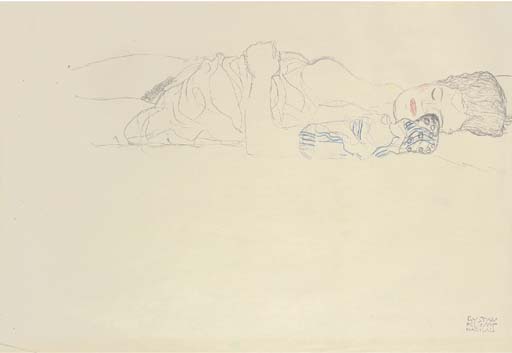
National Gallery of Art (Washington DC)
Christie's 2008
Christie's 2006

National Gallery of Art (Washington DC)
- Klimt, Gustav
- , Austrian, 1862 - 1918
- Baby (Cradle)
- 1917/1918
- oil on canvas
- overall: 110.9 x 110.4 cm (43 11/16 x 43 7/16 in.)
- framed: 116.21 x 115.89 x 6.67 cm (45 3/4 x 45 5/8 x 2 5/8 in.)
- Gift of Otto and Franciska Kallir with the help of the Carol and Edwin Gaines Fullinwider Fund
- 1978.41.1

